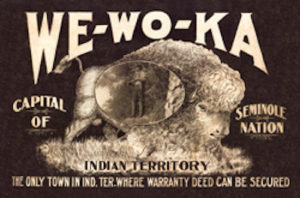
*Wewoka, Oklahoma, is celebrated on this date in 1849. This city in Seminole County, Oklahoma, was founded by a Black Seminole, John Horse.
In the spring of 1849, Horse and a group of Black Seminoles founded a settlement near modern-day Wewoka. Seeking safety and autonomy from the Creek Nation, they established a community at the falls of a small stream, lying in the fertile lands between the North and South Canadian Rivers. The steady rush of water over the falls gave rise to We-Wo-Ka – meaning "Barking Water" in the Mvskoke (Seminole) language. Other historians claim he named the settlement Wewokea after Osceola's second wife, who was of Seminole and African ancestry.
In the autumn of 1849, Horse and Seminole chief Wild Cat led Seminole families into Mexico to avoid the attempts of slavers to raid families and capture people of African descent. The Mexican government offered Wild Cat, Horse, and another Seminole land in Mexico if they could rid the land of renegades who were terrorizing Mexican citizens. Wild Cat was the next hereditary chief of the Seminole Nation, but the government appointed its first chief, John Jumper, instead. The city was founded in 1866 when Elijah J. Brown, an employee of the federal government, led Seminole refugees from Leroy, Kansas, to Indian Territory. During the American Civil War, the Seminole Nation sided with the Confederacy. However, many tribe members fled to the relative safety of Kansas, where they remained for the war.
In 1866, after the Confederacy surrendered, the United States government required the Seminole Nation to sign a new treaty, which required them to emancipate their slaves, give freedmen who wanted to stay in the territory full rights as citizens, including voting in the tribe. Brown led the refugees back to Wewoka, where he built a house and established a trading post. Freedmen settled in Wewoka along with the Seminole, and Elijah Brown was the only legal white settler in the town. The trading post had several subsequent proprietors before it was bought and became the Wewoka Trading Company in 1891. Rev. James Ross Ramsey, a Presbyterian missionary, founded the Ramsey Mission (considered the first school in present-day Seminole County) 1866.
A post office was established on May 13, 1867. The Seminole Nation made Wewoka their capital city, and Seminole Governor John Brown had a log house erected at Wewoka as the Seminole capital in 1877. During the existence of the Seminole Nation as a political entity, the treaty required the federal government to make payments directly to qualified tribe members. Brown was also the treasurer of the Seminole Nation. Brown kept the bulk payment in the company vault until he distributed it directly to the proper recipients. Wewoka exemplifies the historic intersectionality of Native Americans and African Americans.
The Choctaw, Oklahoma, and Gulf Railroad (C O & G) built a railroad line from McAlester to Oklahoma City that passed through Wewoka. The city was formally platted in 1897. The Seminole National Council ordered that decreed that the lots could be sold only to American Indians. However, the decision was overturned in 1902, and sales were opened to white settlers. In 1907, Wewoka became part of the state of Oklahoma, which was admitted to the union. In 1908, it was designated as the county seat of Seminole County. Early newspapers were the Wewoka Herald, Wewoka Democrat, and the Seminole County Capital. On March 16, 1923, oil was discovered two miles southeast of Wewoka by R. H. Smith, part of the Greater Seminole Oil Field. In the 1920s and 30s, the great Seminole Oil Fields were the largest oil suppliers anywhere in the world.
In 1925, the population of Wewoka was 1,520. By 1927, the population had increased to over 20,000 as adventurers and workers came to make their fortunes. It rapidly became the third-largest city in Oklahoma. From 1927 to the present, the oil companies took out as much as possible. As the oil decreased, jobs and people left the city. By 1950, the population of Wewoka was 6,753, and in 1960, it was 6,300. The population steadily declined, but the city continued as the region's commercial center. The 1980s and 1990s were difficult for the city. Businesses left town, and poverty greatly increased. The city leaders tried to protect themselves by refusing to allow competition, like Wal-Mart, to enter the city. Holdenville and Seminole do have Wal-Mart stores. Seminole's Wal-Mart has a super-center configuration offering groceries and dry goods. The crime rate in Wewoka during the 1980s increased.
By the mid-1990s, new leadership began to turn commerce around in the city. The police force increased, and the crime rate became under control. The crime rate by 2001 was below average for the state of Oklahoma. The historic downtown received a facelift of new sidewalks, streets, lights, and flowers. The city of Wewoka continues to work to attract businesses and maintain its population. The projections show that the city will continue to decrease in the coming years. The ethnic diversity continues, with 52% white, 22% American Indian and 18% African American. The average household income is approximately $37,000 yearly, substantially increasing over 2002. According to the demographic comparison, the number of households is decreasing, but the income of those living in Wewoka is rising. The population was 3,430 at the 2010 census.